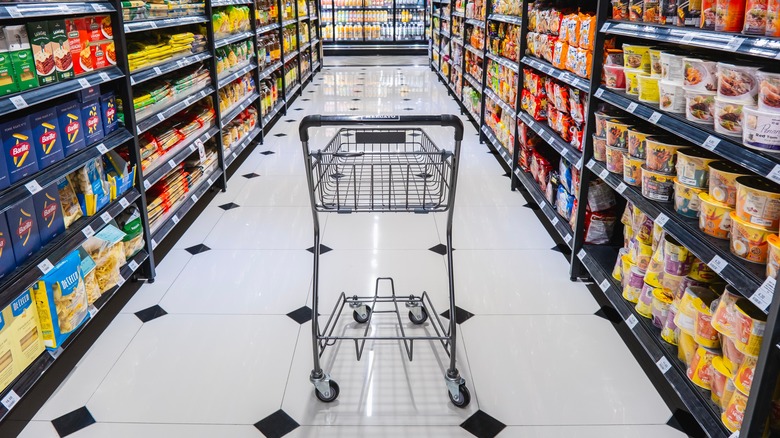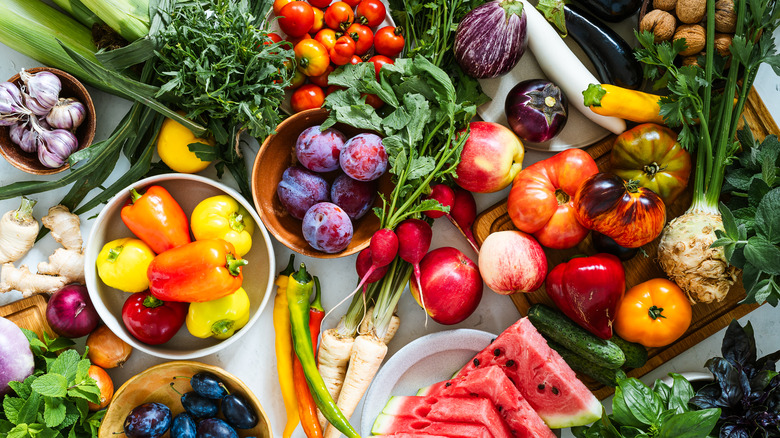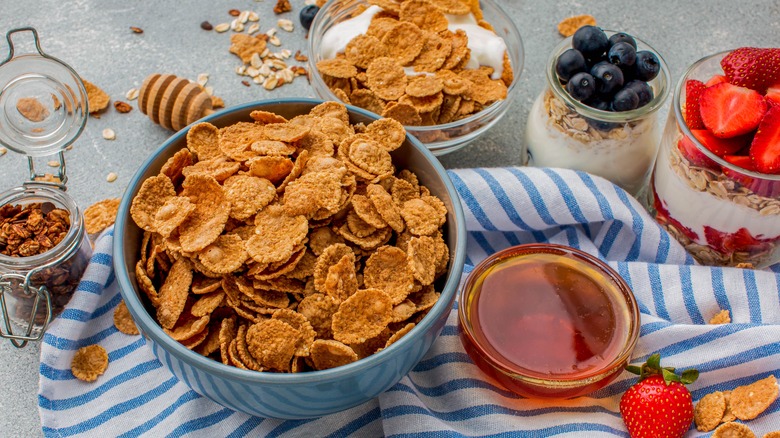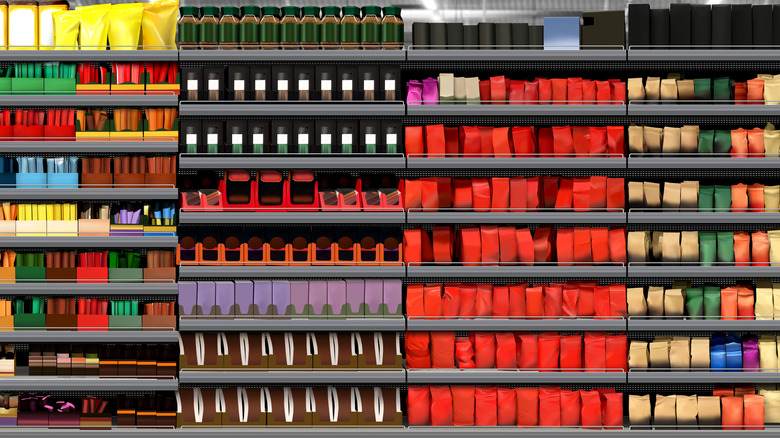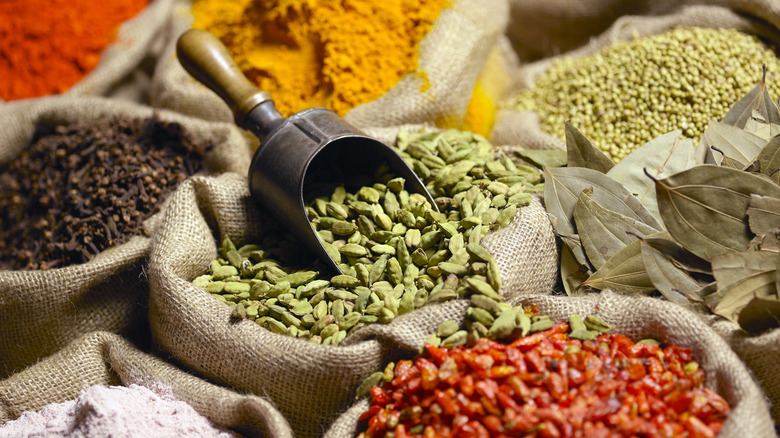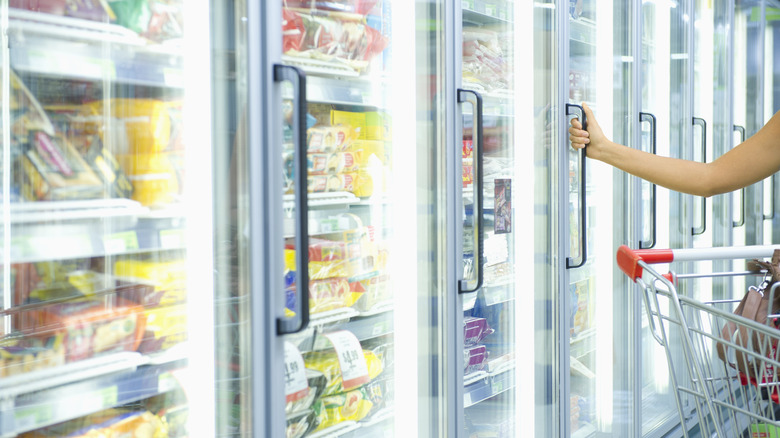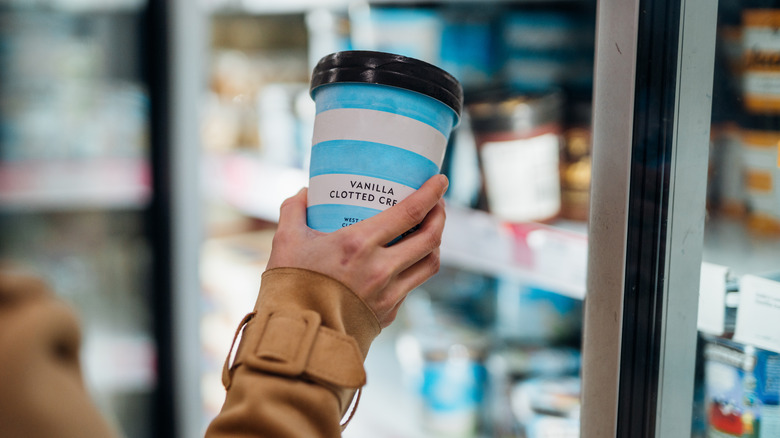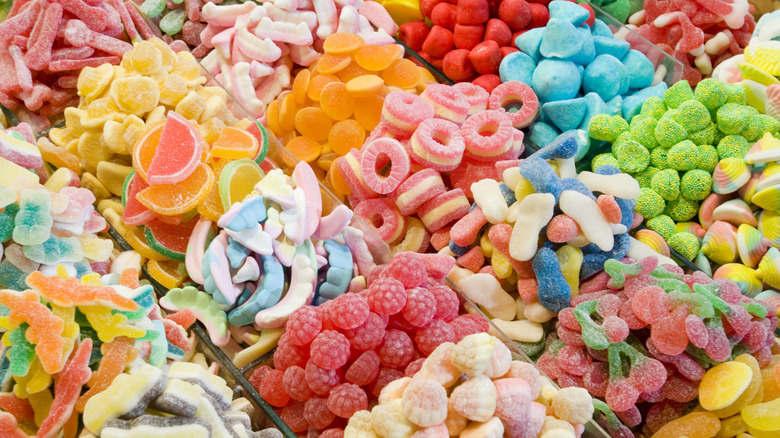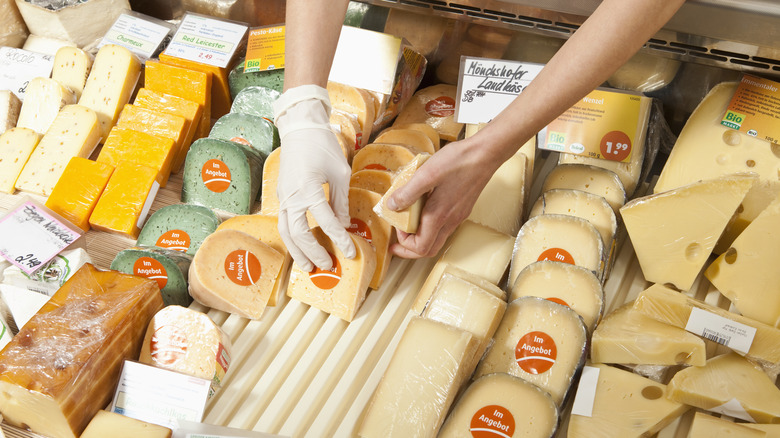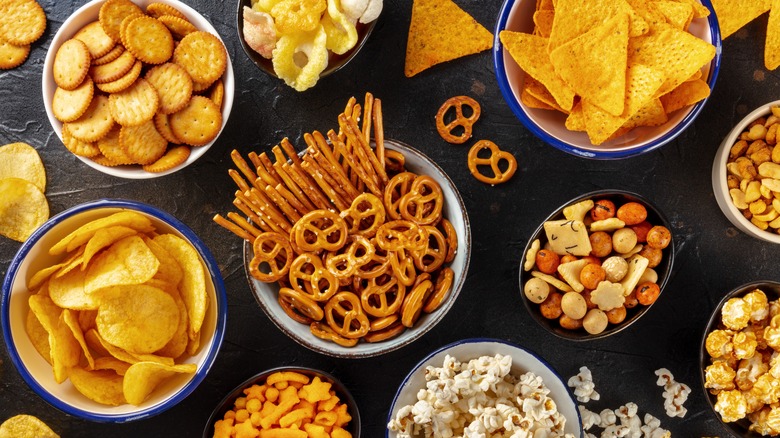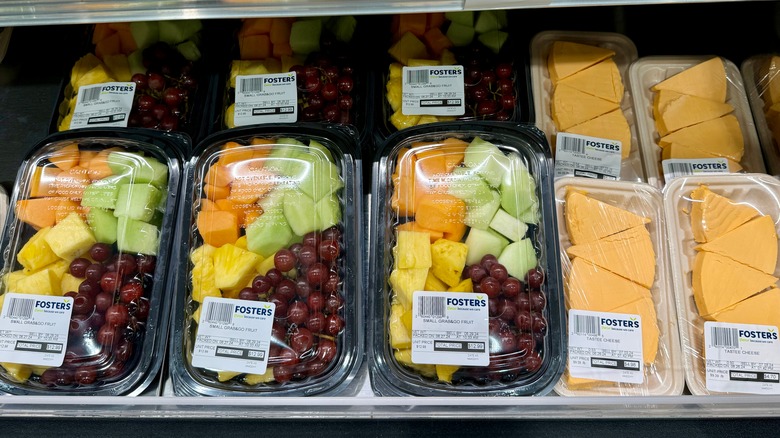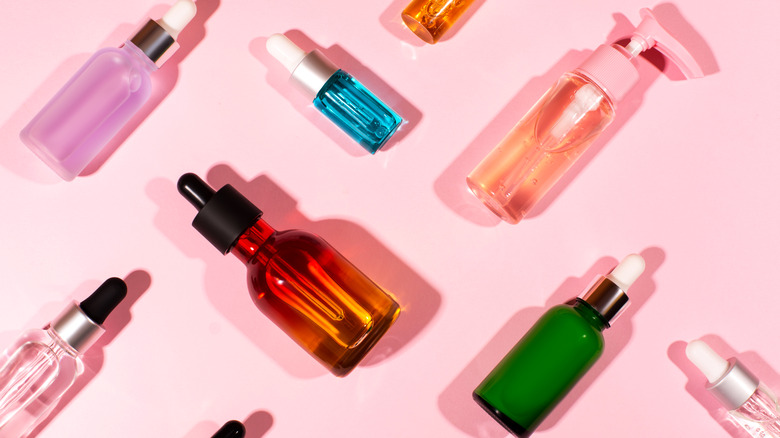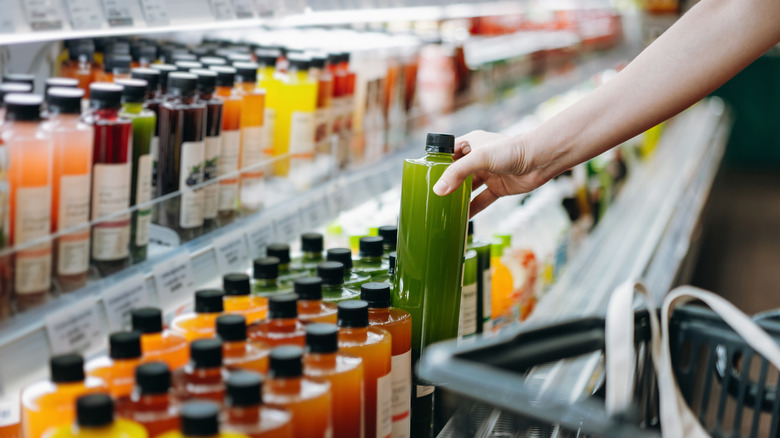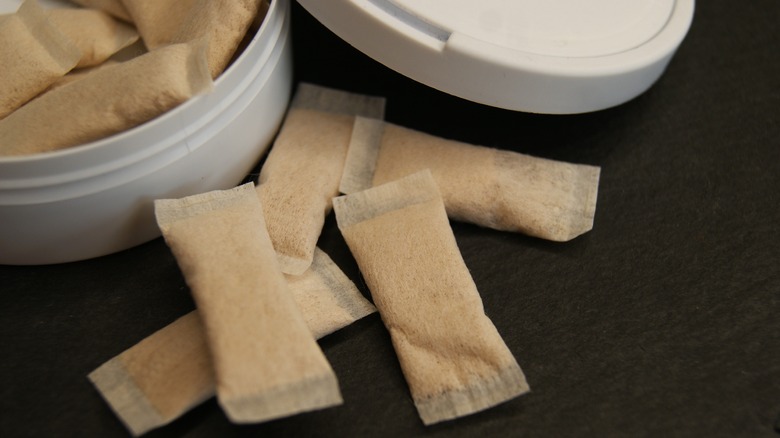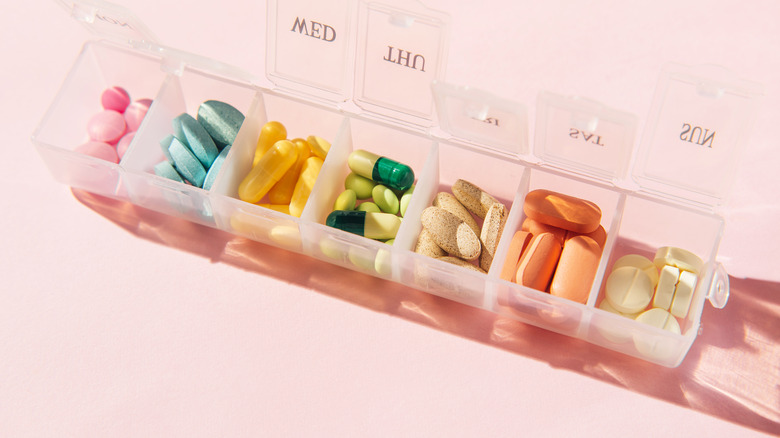Items Grocery Stores Mark Up The Most
A trip to the grocery store can be a serotonin boost for some and a stress inducer for others, depending on one factor: prices. While stores like Aldi tend to keep prices at the lower end, allowing customers to shop on a budget, this isn't the case for many other groceries. With inflation making almost everything expensive, it's pertinent to know what you're paying for, what percentage the brand is getting in profits, and, most importantly, how much markups are raising the prices of common groceries.
Markups are a percentage added to practically all retail items, including groceries, and which pay for the store's costs like rent, utility bills, employee wages, distributor fees, and profit margins. The amount of markup is determined as a percentage that is calculated from a product's profit margin. That number can range significantly, with bottled water having markups in the thousands of percent, while packaged bread may have a markup as low as 29%.
Shopping from some stores means paying less in markups and more in the product's actual cost, such as at warehouse-style stores like Costco. The truth behind Costco's low prices is that its goods are marked up less than other retailers. But since not everyone can shop at Costco, it's important to know which grocery items are often marked up the most.
Produce
When grocery shopping, the produce section is a definite stop for its colorful display of fruits and vegetables — which are typically on the pricier end. That's because produce is a perishable item that is often subjected to a hefty markup. A 2013 markup report on agricultural products by the University of Vermont Extension showed that retailers often charge an 18% markup on produce to cover costs.
However, grocery stores today can charge a much higher markup, estimated at 50%-75% on fruits and vegetables. Berries will have an even higher markup as they are delicate and require careful handling. To put this into perspective, if a farmer spent $0.80 to produce a pound of apples, the distributor will buy from farms and sell it to retailers for $1.20, at a 50% markup rate. The retailer will then sell it to consumers at a similar markup of 50% (about $1.80), approximately the cost per pound of apples in U.S. markets today.
For organic produce the markup ranges from 30%-50%, partially because these crops require extra work and there is little government funding for organic farmers. If you want to purchase your produce without the inflated markups, buying from a farmers market is often an effective cost-saving strategy.
Cereal
Cereal makes up a decent chunk of the American diet, with an estimated 290.32 million Americans consuming cold cereal for breakfast in 2024. Although the price for cereal seems fairly low compared to other grocery items that have seen inflated prices lately, a considerable percentage of that cereal cost is markup. A 2007 study published in the American Journal of Agricultural Economics found the average markup on cereal to be 28%. However, name-brand cereal Kellogg's Corn Flakes had the highest markup at 44%.
Although more recent numbers can be tough to come by, the trend for name-brand cereals being higher in cost (and presumably having a higher markup), still holds strong. Data on the cost of cereal from 2022 to 2023 shows an average price increase of 13.6% across all cereals, while individual products such as Cap'n Crunch, Chex, Fruity Pebbles, and Froot Loops have seen price hikes from 22% to a staggering 42% (via Pattern).
One way to get around the rising costs of your favorite cereals is to buy brands that are on sale. Seems like obvious advice, but it's worth knowing that cereal brands typically go on sale in rotations. So, one week it'll be Post, Kellogg's another, and General Mills the next. You can likely find a good deal on cereal this way (and thank us later).
Coffee
Whether you get your caffeine fix from your favorite coffee place or from a bag of grocery store grounds that you brew every day, you're likely paying a considerable amount for what's in your cup. That's because coffee has become more than a beverage for younger generations, and now arguably constitutes a lifestyle. Where previously older adults made up most of the demographic of coffee drinkers, now 18 to 29-year-olds have become a major part of this group. But have you wondered why this mass-produced and easily available item is priced like it's a hot commodity?
Coffee undergoes many different pricing phases before it reaches your cup. These include the costs of harvesting fruit, distribution, roasting, packaging, and the final retail price end consumers pay. Most coffee places will price their coffee by simply doubling the cost of production, which comes down to a 100% markup that factors in a business's rent and utilities. For newer coffee brands, the markup can be the same or even higher due to the fact that manufacturers need to cover their costs. However, grocery stores will go lower and generally charge a 50% markup on coffee, especially for wholesale products. So, as important as it is to support your local roasters and buy from them, know that it'll be pricier than getting a bag of grounds or beans from the store.
Spices
Buying your groceries from stores like Aldi or stocking up on bulk items at Costco can appeal to many shoppers for lower prices that help you shop on a budget. However, one category you'll have to fork over serious money for no matter what are spices, especially those from name-brands. Grocery store spice markups will have you paying double of what the item is originally worth, at least for name-brands. Generic brands will cost much less, especially when you buy spices from an ethnic grocery store.
This is due to the markup for big name spices such as those from McCormick or Lawry's, which can get as high as 97%, according to savings expert Andrea Woroch. In 2016, she told POPSUGAR that buying your spices from a natural foods store is better, as a jar of bay leaves that costs 12 cents at a natural foods store will cost you around $3.52 at the grocery. One of the reasons for this markup on name-brand spices is packaging. As commenters on one Reddit thread explain, small sealed bottles and jars cost more to produce and fill with spices than the stuff in plastic bags that is more often sold at ethnic stores. Additionally, ethnic store customers reportedly tend to use spices in larger quantities for everyday cooking, so the relatively tiny amount of spices sold at grocery stores would quickly run out for them. These stores also supply wholesale spices to restaurants, which helps to bring down the overall price.
Frozen food
Whether you're meal-prepping for a family or happen to be a college student on a budget, buying frozen can help you save on time and money. However, frozen food at the grocery store is marked up as much as 56%, according to the National Association of Convenience Stores (NACS), which publishes a State of the Industry (SOI) Annual Report on convenience item profits and markups (the most recent freely-available report is currently from 2021). The exact frozen food in question is not specified, so it can include any manner of frozen items such as vegetables, meat, seafood, and more. What's notable is that this percentage has actually fallen over the years, as the same report from 2012 showed an 82% markup on frozen foods.
Although the current markup percentage isn't as high as other grocery store items, it's considerable since buying some frozen foods is widely believed to be cheaper. Generic and newer brands trying to sell frozen products to grocery stores may even use a higher markup value to meet their profit and cost margins, so buying frozen foods from name-brands at the grocery store may indeed be cheaper.
Ice cream
If you get your ice cream fix from the grocery store via a pint of Ben & Jerry's, we're not judging, since getting it from the frozen section is much cheaper than frequenting an artisanal store. With an average tub of name-brand ice-cream falling around $4-$5 from the grocery store freezer, it seems like an affordable, non-expensive item. However, you'll be surprised to learn that packaged ice cream has a 101% markup, according to the National Association of Convenience Stores' SOI from 2021. However, this percentage has at least remained steady over the years, as the markup percentage on packaged ice cream a decade earlier in 2012, was 92%.
If you want to avoid the markup on this frozen delicacy, there are some cheaper options available in stores, but ice-cream is one of the foods you should never buy generic, and always opt for name-brands such as Häagen-Dazs, Breyers, or Ben & Jerry's. That's because cheaper ice cream gets pumped with a lot of air to increase its volume and give it the fluffy look, but you'll be paying for less than you consume in opting for generic brands.
Candy and packaged sweets
If you're anything like us, a trip to the grocery store isn't complete without a stop at the candy aisle. However, the next time you're buying that multipack of Lindt or Nerds, know that grocery stores charge a seriously high markup of about 100%, as per the 2021 NACS report — likely double the store's purchase price. Among these candies, chocolate starts with a high markup during wholesale pricing for retailers, meaning that distributors may increase the price even more.
Packaged sweets such as cookies, biscuits, cakes, pastries, desserts, and more that are sold at grocery stores have a slightly lower markup than candy, at 71%, but is still a fairly large percentage. The markup for sweet snacks has also risen considerably over the years, having been at 49% in 2012. Meanwhile the markup for candy has remained fairly consistent over time, sitting previously at 106%.
Dairy
Dairy products are one of those items at the grocery store that offer a broad range of prices, but one thing that's consistent is the markup. Grocery store dairy, such as butters, creams, and cheese, has a whopping 85% markup value, as per the 2021 NACS report. However, this value is an average of most dairy items, meaning separate products may have a wildly different value. For example, milk typically has a 43% markup according to the same report. Meanwhile, cheese can have anywhere between a 50% to a 100% markup in retail pricing.
While the markup on milk has remained steady over the years at 43%, that doesn't mean its price has stayed the same, a fact that's also true for other dairy products. Milk and butter are getting even more expensive due to the rising costs of buying, feeding, and raising cattle. Combined with the retail markup, it's evident that dairy is on the path to becoming a commodity, if it hasn't already.
Salty snacks
What sets the tone for a good grocery store isn't how fresh its produce section is, but how well-stocked its snack aisles are (at least as far as we're concerned). Stocking up on salty snacks like Doritos or Cheetos can be beneficial for grocery store sales as these are considered cheap snack options to fill up pantries with. In fact, snack and candy stores in the retail sector enjoy a 50% to 70% profit margin on products, depending on sales and operational costs, due to the steadily rising demand for specialty snacks among online consumers.
Aside from a large profit, salty snacks also get a hefty markup of 61% when sold in stores as of 2021, per NACS. There's also a similar markup for alternative snacks, such as popcorn, salted nuts, healthy chips, and more, which comes out to 69%. So if you're looking for the cheapest snack offered by your local grocery store, buy from private-label brands over national or name-brands. They're essentially the same product, but are sold at a lower cost to customers and are typically exclusive to a few stores.
Premade food
For those of us who don't have time to prepare meals from scratch or would like a low-effort meal every once in a while, premade food can be a lifesaver. It saves time on cooking and is usually affordable, whether you get the cult favorite Costco rotisserie chicken or pre-cut fruits and vegetables. Convenience aside, these come with a significant markup. The 2021 NACS report for convenience items lists an average 78% markup for edible prepared groceries. Pre-cut fruits and vegetables had a 40% markup, while prepared meat, like the aforementioned chicken, had a 60% markup.
Premade sandwiches and salads come with a high markup as well, at 44% for commissary or packaged sandwiches. Since premade food also classifies as perishable grocery, as there's a rush to sell it before the expiration date, the markup value is significant. The report also has a 67% markup value for perishable grocery items, but that percentage is more likely associated with produce, since not all premade food is easily perishable, like cured meats and nuts. Non-perishable items like accessories or cooking supplies would have a much lower markup.
Beauty products
While your local grocery store is no Sephora, there's likely an aisle or counter for personal care products. Name-brand health and beauty products usually have a significant price tag and probably an equal markup, but surprisingly, so do the health and beauty products sold at grocery stores. In 2021, the NACS reported a 132% average markup on these items across all brands and products, whether drugstore quality or name-brands.
On the makeup front, brands will use what's called a keystone markup (usually 50% of the product's cost) so consumers will pay double of the production cost. However, this isn't the case for premium or luxury brands, which can sometimes sell products at a much higher markup at nearly 10 times the factory price, or even higher.
If you think you're safe from this exorbitant markup while getting your beauty products at the grocery store, think again. Retail can have a higher markup than brands at five or six times the manufacturing cost.The end consumer has to fork over a pretty penny no matter what product they buy and from where.
Packaged beverages and bottled water
Of all the grocery store products with a high markup value, the most unexpected may be the one on beverages. The NACS reported a whopping 72% markup on non-alcoholic packaged beverages, such as juices, sodas, iced teas, and coffees. Surprisingly, for alcoholic beverages like beer, wine, and liquor, the markup is much lower, coming in between 23% to 38%. Non-alcoholic beverages typically will cost manufacturers much less in production, and the remaining cost is attributed to packaging and distribution, but there is still a significant profit margin on these drinks. CSIMarket reports that the profit on non-alcoholic beverages was nearly 50% in 2023, then increased to around 57% in 2024.
Another significant markup is the one associated with bottled water, which costs manufacturers only a few cents to make but is often sold for $1 to $2, factoring in a markup in a 4000% markup or higher. However, these numbers aren't necessarily very accurate, as water costs less than $0.00001, while the remaining cost charged to end consumers is a huge markup on bottle production, packaging, marketing, and more.
Cigarettes and other tobacco products
The availability and pricing of cigarettes and other tobacco products like nicotine pouches, gels, and dissolvable tobacco products varies by state and is subjected to a different markup value based on state laws and regulations. In 2009, the CDC had a 6% to 25% markup imposed in 25 out of 50 U.S. states. However, a 2013 study published in Tobacco Control found that cigarette minimum price laws (MPLs) were not properly enforced in many states, which could be due to state markups being lower than free-market markups on cigarette pricing.
These MPLs are put in place to discourage cigarette purchases via higher prices. The study suggested state laws impose an actual minimum price for cigarettes, as MPLs can be disregarded in promotions and discounts. The NACS 2021 report noted a 16% markup on cigarettes sold in grocery stores, which is within the CDC's numbers, while other tobacco products had a 41% markup.
Supplements and over-the-counter medications
When it's difficult to get in all essential nutrients from your diet alone, supplements are often suggested as a way to maintain a steady intake of vitamins and minerals. Most supplements sold at convenience stores come from name-brands and are growing in demand. But you may be paying a pretty penny in the name of premium formulas, aesthetic packaging, and niche products for specific audiences, to the tune of a 40% or higher profit margin. The markup on supplements ranges from 40% to 100% depending on the product. Yet quality may be questionable and is one of the reasons you should think twice about buying vitamins at the dollar store.
Likewise, some over-the-counter medications will also have a significant markup and profit margin, especially brand-name medications that can be 30% to 40% more expensive than generic ones. The markup on these products is even more alarming, ranging from 350% to near 400% for products like acne treatment, antibiotics, antacids, condoms, allergy medication, painkillers, and vitamins (via NBC). Although these reported percentages date back more than a decade, they're a good indicator of the inflated price you're likely still paying for common OTC medication.
